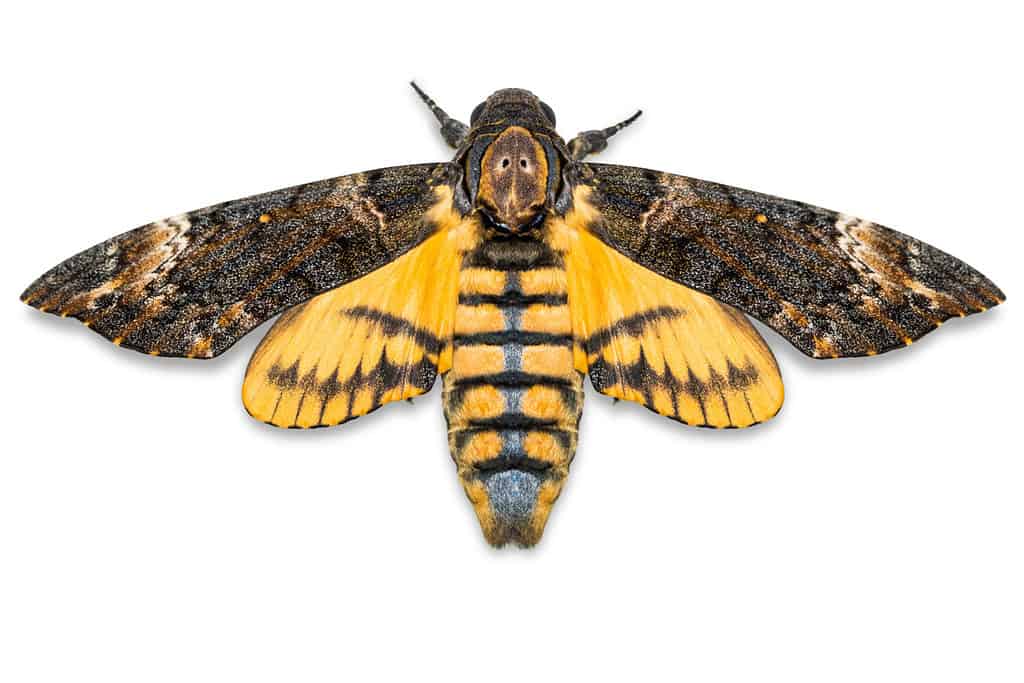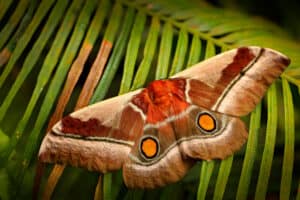Moths and butterflies belong to the same insect family, the Lepidoptera. This category encompasses over 180,000 species. The butterfly and moth have their behavioral and physical differences. That includes butterflies being active during the day while moths are nocturnal.
The stages between larva and adult have their distinctions too. What follows is an in-depth review of moth vs butterfly.
It will cover major differences like their frenulum, wings, body and pupa stages, and more.
8 Key Differences Between Moth and Butterfly
Here are eight unique differences that help identify the moth versus the butterfly.
1. Moth vs Butterfly: Behavior
Butterflies are ectotherms. They rely on heat from external sources. To fly, their temps need to be about 85 degrees, so they use the sun to raise their body temperatures.
Moths prefer to rest during the day, usually in a wooded, dark habitat. Indoors, they look for dark environments, like cabinets and closets. Curiously, similar to the butterfly, the moth needs heat, but they heat themselves by vibrating their wings.
2. Moth vs Butterfly: Feeding
Butterflies pull nectar from flowers. Some species drink tree sap and fruit juices. Others feed on moisture from carrion or dung. Butterflies also partake of pollen and nutrients like salt which they get from muddied areas and puddles.
Moths do not eat textile, the larvae do. The webbing clothes moth and case-making clothes moth are commonly feasting on fabrics. They enjoy natural fibers in curtains, bed sheets, upholstery, and clothes, and have an appreciation for wool, silk, cotton, cashmere, and lint.
Most moths live on a liquid diet, obtaining it from variety of sources including liquids from flower nectar, rotting fruit, bird droppings, sap, honeydew, and even animal dung.
3. Moth vs Butterfly: Flight Patterns
Butterflies have two wings on each side of their bodies. The infrastructure is such that the wings move independently. Some species appear to dart with ease while others, with a few flaps, soar at leisurely paces.
Moth wings are scaled. Air trapped in the scales lifts them. The scales are beneficial to survival. If caught in a spider’s web, the scales detach. Unfortunately, these scales are colorful to the sharp eye of a flying predator. But the moth’s developed an erratic pattern of flight many birds can’t follow.
4. Moth vs Butterfly: Larvae Stage
For the butterfly caterpillar, the main job is to eat and eat and eat to ensure the healthy growth of the caterpillar. The cocoon can start at the size of a pinhead and end up to two inches long. The caterpillar is capable of shedding its skin up to four times to accommodate the butterfly’s growth.
Moth larvae infest primary sources of food. They prefer undisturbed, dark areas where food is easily accessible. That’s why the clothes moth makes upholstered furnishings and closets its home. Moths also make themselves comfortable in animal or bird nests, wall cavities, or chimneys.
5. Moth vs Butterfly: Reproduction
If the caterpillar stage is solely to eat for the sake of growth, the adult butterfly’s job is mating and laying eggs. The female will fly great distances to plant its eggs.
Female moths may lay a single egg or batches. Eggs are often left in plant tissue, but females also stick eggs to objects or drop them. While most moths mate, there are exceptions like the European bagworm. It uses parthenogenesis to reproduce.
6. Moth vs Butterfly: Wing Coloration
Butterflies, of course, are famous for the bright and unique patterns of their wings. There are exceptions though, such as the baron butterfly or the cabbage white butterfly. Both these insects aren’t the rainbow of colors we marvel over when we see a butterfly.
The nocturnal moth is better known for being a dull flat color. There are often patterns of obscuring swirls or zigzags that camouflage them from predators. But there are species with wondrous coloration. These exceptions, unfortunately, may also be toxic.
7. Moth vs Butterfly: Structure of Antenna
Butterflies tend to have slender, thin, filamentous, club-shaped antennas. These are segmented organs and are sensory appendages, used for balance and smell.
Moths have a feathery, comb-like, feathery antenna. Similar, to the butterfly, the antenna serves a function as a source for orientation. They use them to detect mates and find food. Each hair has a scent receptor. It’s considered stronger than the butterfly. Some species of male moths have the potential to smell a possible mate over six miles away.
8. Moth vs Butterfly: Lifespans
The adult butterfly lives no longer than two weeks. But some species hibernate throughout the winter. These butterflies can live for several months.
Depending on the species, a moth can live seven days or 10 months. It’s said that most adult moths do not reach old age. Environmental factors and predators are more likely to end their lives.
A Summary Comparing Moth vs Butterfly
| Moth | Butterfly | |
|---|---|---|
| Wings | Moths land with wings spread. They also rest with their wings open. Moths are typically smaller with drab-colored wings. | Butterflies land with wings folded back. Their wings are closed when at rest. Butterflies are typically larger and have more colorful patterns on their wings. |
| Antenna | Moths have short feathery antenna. Often with a sawed edge. You can find moths with an antenna similar to the butterfly but you won’t find butterflies with a feathery antenna. | Butterflies have thin, long antennas. Almost club-shaped with a bulb and shaft at the end. |
| Activity | Moths generally are more active at night, looking to feed. | Butterflies spend their days gathering food. |
| Pupa Stage | Moths create a silky cocoon. But not all moths follow this fashion. One example is the tomato hornworm. It designs a pupation chamber in the ground. | Butterflies make a shiny chrysalis. The shell tends to be hard, silkless, and smooth. |
| Frenulum The frenulum is the wing-coupling that joins the fore-and hindwing. | Depending on the species, a moth may or may not have a frenulum | Outside of the Australian Regent Skipper, there appears to be no other butterfly with a frenulum. |
| Caterpillars | In its caterpillar stage, the moth stage is fuzzy. | In this stage, the caterpillar’s coat is smoother than a moth’s. |
| Body shape | Moths are shorter than butterflies, have thicker hair and their bodies are fatter. | Butterfly bodies are skinner and, longer, and their bodies, compared to the moth, tend to be longer as well. |
What Does It Mean To Dream About a Moth?

Dreaming of moths? It could mean you are on a path of transformation.
©Matee Nuserm/Shutterstock.com
Moths are actually often associated with dreams and intuition. If you’re seeing a moth in your dream, it could indicate that you are about to enter a time of personal growth. Moths symbolize transformation, so you could be on a path of self-discovery and transformation. If the moth in your dream is fluttering about without direction, it could mean you’re feeling confused or lost. If it’s flying toward light, your life is heading in the right direction.
The photo featured at the top of this post is ©
FAQs (Frequently Asked Questions)
How does a moth differ from a butterfly?
They differ in many ways despite their similarities. Moths are nocturnal. They probably have stronger senses than the butterfly. The moth operates in different habitats.
Are moths and butterflies closely related?
Moths and butterflies are both from the Lepidoptera insect family.
Why do we like butterflies but not moths?
Viscerally, we associate butterflies with flowers and beautiful weather. We tend to see the moth as a dark creature that darts out of our dark spaces and destroys our clothes.
How does a moth turn into a butterfly?
The cocoon of either insect turns into either a butterfly or moth. Moths do not turn into butterflies or vice versa.
Thank you for reading! Have some feedback for us? Contact the AZ Animals editorial team.






